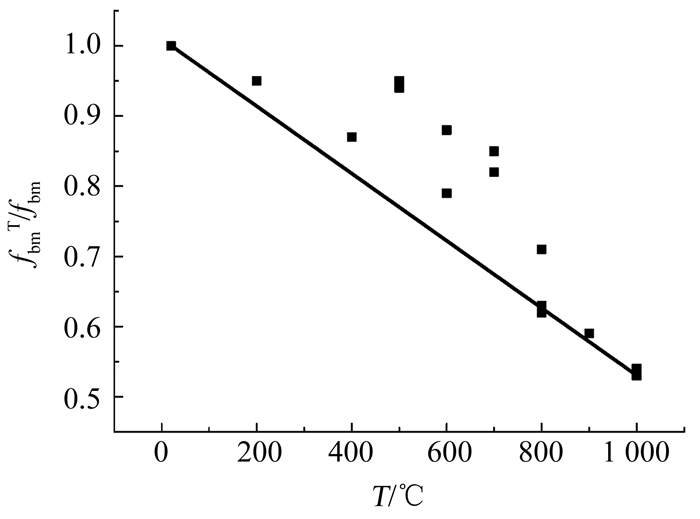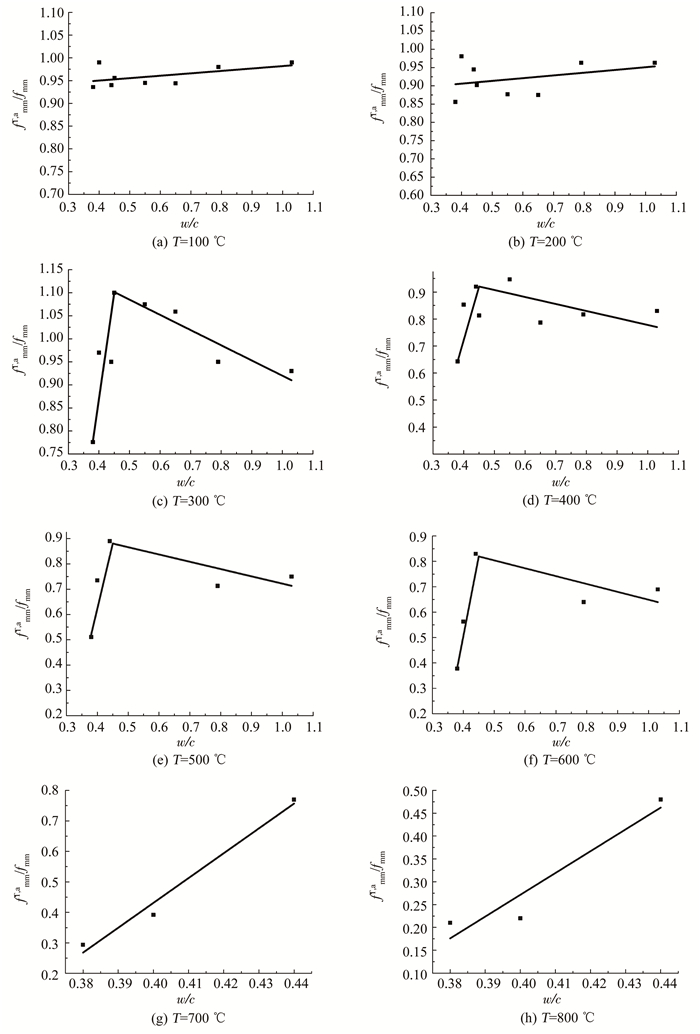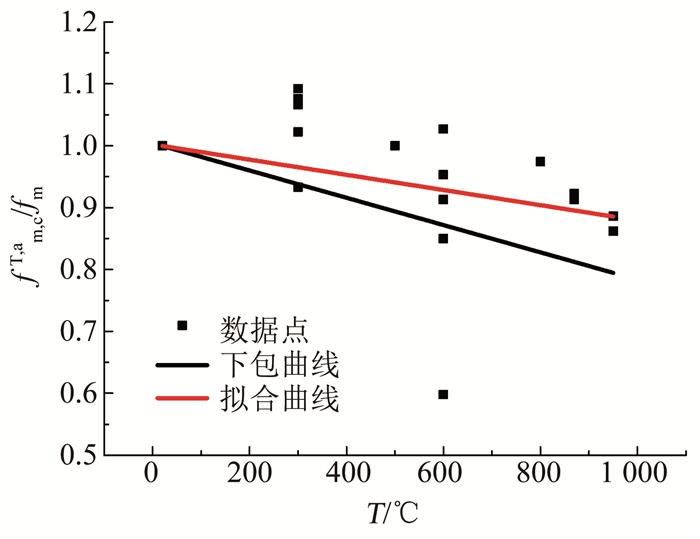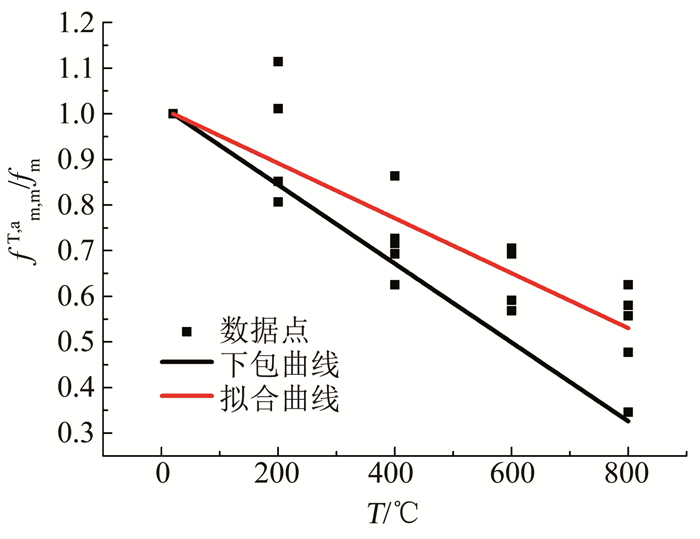火灾是高频灾种[1-3], 建筑火灾是最常见的火灾, 2014—2016年中国共发生火灾104.5万起, 火灾直接财产损失120亿元[4-6].砌体主要是由块材和砌筑浆体砌筑而成的受力构件.块材主要有黏土砖、石材、混凝土砌块等.砌筑浆体主要为砂浆, 也有用土坯做块材用泥巴做砌筑浆体的情况.
用混凝土砌块和砂浆砌筑而成砌体的耐高温性能可借鉴混凝土结构高温性能研究的成果进行考察.用土坯和泥巴砌筑而成的砌体目前已很少应用, 不做讨论.本文在阅读相关文献的基础上, 着力对砖砌体的抗火性能研究进展进行论述, 包括黏土砖高温下和高温后的力学性能、砂浆高温后的力学性能和砖砌体高温后的力学性能.基于相关试验结果, 建立了高温下和高温后黏土砖抗压强度折减系数计算公式、水泥砂浆高温后的抗压强度折减系数计算公式以及高温后水泥砂浆和混合砂浆砖砌体抗压强度折减系数计算公式.对用具有良好耐高温性能的碱矿渣胶凝材料做砌块和砌筑浆体的新型砌体的应用前景进行了展望.
1 材料的高温力学性能 1.1 黏土砖高温力学性能 1.1.1 资料收集文献[7]对普通黏土实心砖和KP1型黏土空心砖进行了高温下抗压强度试验, 实心砖和空心砖常温下抗压强度分别为37.9和38.3 MPa, 升温速度为6~8 ℃/min, 恒温40 min后进行高温下抗压试验, 结果如表 1所示.
| 表 1 文献[7]高温下黏土砖抗压强度试验数据 Tab. 1 Test data of compressive strength of clay brick at high temperature in Ref.[7] |
分析力学性能变化的微观原因.500 ℃时, 高岭石变成了煅烧高岭石, 孔洞增加, 降低了抗压强度.800 ℃时微结构几乎没有变化, 但在此温度下孔结构和玻璃体微结构更易破碎, 导致强度大幅下降[11-13].
文献[8]采用的试件尺寸为112.5 mm×112.5 mm×75 mm, 常温强度为5 MPa.以2 ℃/min的速度加热到目标温度恒温1 h后, 进行了高温下试验, 发现历经温度在800 ℃时, 抗压强度是常温强度的71%.试验结果如表 2所示.
| 表 2 文献[8]高温下黏土砖抗压强度试验数据 Tab. 2 Test data of compressive strength of clay brick at high temperature in Ref.[8] |
文献[9]进行了黏土砖的高温后抗压强度试验, 常温强度为19.17 MPa.为了模拟实际火灾情况, 升温时间和恒温时间都尽可能短, 并在空气中自然冷却, 300和600 ℃后黏土砖的残余强度分别为常温的80%和60%左右.试验结果如表 3所示.
| 表 3 文献[9]高温后黏土砖抗压强度试验数据 Tab. 3 Test data of compressive strength of clay brick after high temperature in Ref.[9] |
文献[10]对强度等级为MU20的黏土砖进行高温后力学性能研究, 试验只选用了800 ℃以上的3个温度, 在空气中冷却后进行抗压强度试验.结果表明, 875 ℃时抗压强度只下降5%, 898 ℃时下降16%.试验数据如表 4所示.
| 表 4 文献[10]高温后黏土砖抗压强度试验数据 Tab. 4 Test data of compressive strength of clay brick after high temperature in Ref.[10] |
因数据样本很少, 不能得到高温下和高温后黏土砖抗压强度随历经温度的准确规律, 本文只拟合了高温下和高温后具有95%保证率的黏土砖抗压强度折减系数的下包曲线.图 1为高温下黏土砖抗压强度折减系数fbmT/fbm与T的下包曲线, 高温下黏土砖抗压强度折减系数公式为

|
图 1 高温下黏土砖抗压强度折减系数fbmT/fbm与T的下包曲线 Fig. 1 Envelope curve of fbmT/fbm and T |
| $ \begin{array}{*{20}{l}} {f_{{\rm{bm}}}^{\rm{T}}/{f_{{\rm{bm}}}} = 1.000 - 4.796 \times {{10}^{ - 4}}(T - 20),}\\ {20\ ℃{\kern 1pt} {\kern 1pt} \le T \le 1000\ ℃{\kern 1pt} {\kern 1pt} ,T < 20\ ℃{\kern 1pt} {\kern 1pt} {\rm{ 时取 }}T = 20\ ℃{\kern 1pt} {\kern 1pt} {\kern 1pt} {\kern 1pt} .} \end{array} $ | (1) |
图 2为高温后具有95%保证率的黏土砖抗压强度折减系数fbmT/fbm与T的下包曲线, 因历经温度高于600 ℃后的黏土砖高温后抗压强度数据较少, 且离散性较大, 所拟合的下包线只适用于20 ℃≤T≤ 600 ℃, 高温后黏土砖抗压强度公式为

|
图 2 高温后黏土砖抗压强度折减系数fbmT, a与T的下包曲线 Fig. 2 Envelope curve of fbmT, a and T |
| $ \begin{array}{*{20}{l}} {f_{{\rm{bm}}}^{{\rm{T,a}}}/{f_{{\rm{bm}}}} = 1.000 - 7.552 \times {{10}^{ - 4}}(T - 20)},\\ {{{20}\ ℃} \le T \le {{600}^{\rm{^\circ }}}{\rm{C}},T < {{20}\ ℃}{\rm{时取 }}T = {{20}\ ℃}.} \end{array} $ | (2) |
在CECS252—2009《火灾后建筑结构鉴定标准》[14]中给出了高温后黏土砖抗压强度折减系数.根据式(2)计算的高温后黏土砖抗压强度折减系数与文献[14]给出的折减系数如表 5所示.文献[14]认为黏土砖高温后抗压强度在经历温度不高于700 ℃时不降低.式(2)计算结果表明, 黏土砖抗压强度在100 ℃高温后就下降, 600 ℃高温后的抗压强度折减系数为0.562.
| 表 5 高温后黏土砖抗压强度计算值与规范值对比 Tab. 5 Comparison between calculated and code values of compressive strength of clay brick after high temperature |
文献[15]通过对强度等级为M10和M20的水泥砂浆在不同温度后的抗压强度进行试验研究, 得到历经温度对其高温后抗压强度的影响规律.强度等级为M10和M20的水泥砂浆实测常温强度分别为11.91和23.25 MPa, 水灰比w/c分别为1.03和0.79, 采用的升温速率为10 ℃/min, 达到目标温度后, 恒温90 min.结果表明, 若历经温度不高于300 ℃, 高温后抗压强度下降较小; 若历经温度超过450 ℃, 高温后抗压强度下降明显, 结合水的脱出使得砂浆结构疏松.试验结果见表 6.
| 表 6 文献[15]高温后水泥砂浆抗压强度试验数据 Tab. 6 Test data of compressive strength of cement mortar after high temperature in Ref.[15] |
文献[17]研究了强度等级为M30的水泥砂浆高温后抗压强度变化规律.水泥砂浆的实测常温强度为39.0 MPa, 水灰比为0.44, 采用的升温速率为3~5 ℃/min, 达到目标温度后恒温4 h.自然冷却后进行抗压强度试验, 结果见表 7.
| 表 7 文献[17]高温后水泥砂浆抗压强度试验数据 Tab. 7 Test data of compressive strength of cement mortar after high temperature in Ref.[17] |
文献[18]研究了高温后水泥砂浆抗压强度的变化规律.水灰比为0.4, 砂采用河砂.试验前先将试件放入烘干箱烘干至恒重, 再放入高温炉内加热, 加热至目标温度后恒温2 h, 再自然冷却至室温后进行抗压强度试验.试验结果见表 8.
| 表 8 文献[18]高温后水泥砂浆抗压强度试验数据 Tab. 8 Test data of compressive strength of cement mortar after high temperature in Ref.[18] |
文献[19]进行了强度等级为M30的水泥砂浆高温后的力学性能试验, 水灰比为0.38.升温速率为2 ℃/min, 恒温1 h.自然冷却后进行抗压强度试验, 试验结果见表 9.
| 表 9 文献[19]高温后水泥砂浆抗压强度试验数据 Tab. 9 Test data of compressive strength of cement mortar after high temperature in Ref.[19] |
文献[20]中研究了高温后水泥砂浆抗压强度随温度的变化规律.加热时以20 ℃/min的升温速率升到目标温度恒温2 h, 自然冷却至室温后再进行抗压强度试验.研究表明, 温度为200 ℃时, 抗压强度小幅下降, 300 ℃时抗压强度高于常温强度, 400 ℃时再次下降.试验数据见表 10.
| 表 10 文献[20]高温后水泥砂浆抗压强度试验数据 Tab. 10 Test data of compressive strength of cement mortar after high temperature in Ref.[20] |
以文献[15-20]的数据为基础, 分析高温后水泥砂浆抗压强度折减系数fmmT, a/fmm随水灰比w/c和历经温度T的变化关系.当T>800 ℃时, 不同文献的数据偏差很大, 故只拟合T≤800 ℃时高温后水泥砂浆抗压强度折减系数公式.fmmT, a/fmm随水灰比w/c先增大后减小.经历温度不超过300 ℃时, 自由水和少部分结合水脱出, 影响砂浆的孔隙形态, 但由于钙矾石的分解, 水泥熟料重新暴露在空气中, 与空气中的水进行水化.历经温度超过300 ℃时, 结合水进一步脱出, 并随温度升高, 水化硅酸钙分解, 强度大幅下降.水灰比很小时, 自由水含量很低, 结合水很快开始脱出, 强度下降较快; 水灰比过大时, 自由水含量很高, 大量自由水会造成孔隙增大产生裂缝[16].
以文献[15-20]的数据为基础, 通过线性插值获取不同温度时水泥砂浆抗压强度折减系数数据, 分别以水灰比w/c为水平坐标轴, 以fmmT, a/fmm为竖轴, 建立二维坐标系, 绘制如图 3所示的不同温度时fmmT, a/fmm与w/c的拟合曲线, 得不同温度时高温后水泥砂浆抗压强度折减系数计算公式:

|
图 3 fmmT, a/fmm随w/c的拟合曲线 Fig. 3 Fitting curves of fmmT, a/fmm with w/c |
| $ \begin{array}{*{20}{l}} {T = {{100}\ ℃}{\rm{时}}{\rm{ }}},\\ {f_{{\rm{mm}}}^{{\rm{T,a}}}/{f_{{\rm{mm}}}} = 0.929 + 0.053(w/c),0.38 \le w/c \le 1.03.} \end{array} $ | (3) |
| $ \begin{array}{*{20}{l}} {T = {{200}\ ℃}{\rm{时}}{\rm{ }}},\\ {f_{{\rm{mm}}}^{{\rm{T,a}}}/{f_{{\rm{mm}}}} = 0.876 + 0.075(w/c),0.38 \le w/c \le 1.03.} \end{array} $ | (4) |
| $ \begin{array}{*{20}{l}} {T = {\rm{30}}{{\rm{0}}\ ℃}{\rm{时 }}},\\ {f_{{\rm{mm}}}^{{\rm{T,a}}}/{f_{{\rm{mm}}}} = \left\{ {\begin{array}{*{20}{l}} { - 0.97 + 4.6(w/c),0.38 \le w/c < 0.45};\\ {1.248 - 0.328(w/c),0.45 \le w/c \le 1.03.} \end{array}} \right.} \end{array} $ | (5) |
| $ \begin{array}{*{20}{l}} {T = {{400}\ ℃}{\rm{时 }}},\\ {f_{{\rm{mm}}}^{{\rm{T,a}}}/{f_{{\rm{mm}}}} = \left\{ {\begin{array}{*{20}{l}} { - 0.861 + 3.957(w/c),0.38 \le w/c < 0.45;}\\ {1.037 - 0.259(w/c),0.45 \le w/c \le 1.03.} \end{array}} \right.} \end{array} $ | (6) |
| $ \begin{array}{*{20}{l}} {T = {{500}\ ℃}{\rm{时, }}}\\ {f_{{\rm{mm}}}^{{\rm{T,a}}}/{f_{{\rm{mm}}}} = \left\{ {\begin{array}{*{20}{l}} { - 1.434 + 5.143(w/c),0.38 \le w/c < 0.45;}\\ {1.010 - 0.288(w/c),0.45 \le w/c \le 1.03.} \end{array}} \right.} \end{array} $ | (7) |
| $ \begin{array}{*{20}{l}} {T = {{600}\ ℃ }{\rm{时, }}}\\ {f_{{\rm{mm}}}^{{\rm{T,a}}}/{f_{{\rm{mm}}}} = \left\{ {\begin{array}{*{20}{l}} { - 2.009 + 6.286(w/c),0.38 \le w/c < 0.45;}\\ {0.959 - 0.310(w/c),0.45 \le w/c \le 1.03.} \end{array}} \right.} \end{array} $ | (8) |
| $ \begin{array}{*{20}{l}} {T = {{700}\ ℃ }{\rm{ 时, }}}\\ {f_{{\rm{mm}}}^{{\rm{T,a}}}/{f_{{\rm{mm}}}} = - 2.829 + 8.15(w/c),0.38 \le w/c \le 0.44.} \end{array} $ | (9) |
| $ \begin{array}{*{20}{l}} {T = {{800}\ ℃ }{\rm{ 时 }},}\\ {f_{{\rm{mm}}}^{{\rm{T,a}}}/{f_{{\rm{mm}}}} = - 1.637 + 4.771(w/c),0.38 \le w/c \le 0.44.} \end{array} $ | (10) |
式中:fmmT, a/fmm为高温后水泥砂浆抗压强度折减系数; fmm为常温下水泥砂浆抗压强度, MPa; T为历经温度, ℃; w/c为水灰比.
采用的试验数据与相应的计算结果对比见表 11.经统计分析,
| 表 11 高温后水泥砂浆抗压强度折减系数计算值与实测值对比 Tab. 11 Comparison between calculated and test values of reduction coefficient of compressive strength of cement mortar after high temperature |
文献[9]对黏土实心砖墙进行高温后抗压试验研究, 得到抗压强度随温度的变化规律.墙厚250 mm, 墙高和墙宽为510 mm.采用M10水泥砂浆砌筑, 黏土砖和水泥砂浆常温强度分别为19.17 MPa和13.0 MPa.升温速率为20 ℃/min, 达到目标温度后恒温1 h.结果表明, 高温后抗压强度在300 ℃时略有增加, 600 ℃时平均下降了13%.试验数据见表 12.
| 表 12 文献[9]高温后砖砌体抗压强度试验数据 Tab. 12 Test data of compressive strength of brick masonry after high temperature in Ref.[9] |
文献[10]研究高温后砖和砂浆的强度变化, 砖的强度等级为MU20, 砂浆强度等级为M5和M10, 给出高温后强度折减系数, 并参考GB50003—2011《砌体结构设计规范》给出砖砌体抗压强度平均值的计算公式, 给出了高温后砖砌体抗压强度平均值的计算公式:
| $ {f_{{\rm{mt}}}} = {K_1}{({C_{{\rm{t1}}}}{f_1})^\alpha }(1 + 0.07{C_{{\rm{t2}}}}{f_2}){K_2}. $ | (11) |
式中:fmt为高温后无筋砖砌体的抗压强度平均值; f1为常温下黏土砖的抗压强度平均值; f2为常温砂浆的抗压强度平均值; α为参数, 等于0.5;K1为无筋砖砌体受压安全系数, 等于0.78;K2为砂浆强度抗压计算系数.当f2<1时, K2=0.6+0.4f2; 当f2>1时, K2=1;Ct1为火灾后砖抗压强度折减系数; Ct2为火灾后砂浆抗压强度折减系数.根据式(11)计算的结果见表 13所示.
| 表 13 文献[10]高温后砖砌体抗压强度计算值 Tab. 13 Calculated values of compressive strength of brick masonry after high temperature in Ref.[10] |
文献[21]等对经历不同温度后的黏土砖墙试件进行抗压强度试验, 得到砖墙抗压强度随温度的变化规律.试件尺寸为746 mm×365 mm×115 mm, 采用强度等级为M10的混合砂浆.升温速率为5 ℃/min, 达到目标温度后恒温1 h.结果表明, 砖墙在经历800 ℃高温后, 强度降低44%.文献[21]的砖墙高温后抗压强度数据见表 14.
| 表 14 文献[21]高温后砖砌体抗压强度试验数据 Tab. 14 Test data of compressive strength of brick masonry after high temperature in Ref.[21] |
文献[22]等研究了砖墙高温后的抗压强度变化规律, 试件尺寸为189 mm×120 mm×115 mm, 采用强度等级为M10的混合砂浆.发现砖墙抗压强度随温度升高不断下降, 在800 ℃高温后, 抗压强度为常温的65%左右.试验数据见表 15.
| 表 15 文献[22]高温后砖砌体抗压强度试验数据 Tab. 15 Test data of compressive strength of brick masonry after high temperature in Ref.[22] |
文献[9-10]中采用的砂浆为水泥砂浆, 文献[21-22]中采用的砂浆为混合砂浆, 本文拟合了砂浆分别为水泥砂浆和混合砂浆的高温后砖砌体抗压强度折减系数的下包曲线和拟合曲线.图 4为高温后用水泥砂浆砌筑的砖砌体抗压强度折减系数fm, cT, a与T具有95%保证率的下包曲线和拟合曲线, 得到高温后用水泥砂浆砌筑的砖砌体抗压强度折减系数标准值和平均值公式:

|
图 4 高温后用水泥砂浆砌筑的砖砌体抗压强度折减系数fm, cT, a/fm与T的下包曲线和拟合曲线 Fig. 4 Envelope curve and fitting curve of fm, cT, a/fm and T |
| $ \begin{array}{*{20}{l}} {f_{{\rm{m,c}}}^{{\rm{T,a}}}/{f_{\rm{m}}} = 1.000 - 2.204 \times {{10}^{ - 4}}(T - 20),}\\ {{{20}\ ℃} \le T \le {{950}\ ℃},T < {{20}\ ℃}{\rm{ 时取 }}T = {{20}\ ℃},} \end{array} $ | (12) |
| $ \begin{array}{*{20}{l}} {f_{{\rm{m,c}}}^{{\rm{T,a}}}/{f_{\rm{m}}} = 1.000 - 1.226 \times {{10}^{ - 4}}(T - 20),}\\ {{{20}\ ℃} \le T \le {{950}\ ℃},T < {{20}\ ℃}{\rm{ 时取 }}T = {{20}\ ℃}.} \end{array} $ | (13) |
式中:fm, cT, a/fm为高温后用水泥砂浆砌筑的砖砌体抗压强度折减系数; fm为常温砖砌体抗压强度, MPa; T为历经温度, ℃.
图 5为高温后用混合砂浆砌筑的砖砌体抗压强度折减系数fm, mT, a/fm与T具有95%保证率的下包曲线和拟合曲线, 得到高温后用混合砂浆砌筑的砖砌体抗压强度折减系数标准值和平均值公式分别为

|
图 5 高温后用混合砂浆砌筑的砖砌体抗压强度折减系数fm, mT, a/fm与T的下包曲线和拟合曲线 Fig. 5 Envelope curve and fitting curve of fm, mT, a/fm and T |
| $ \begin{array}{*{20}{l}} {f_{{\rm{m,c}}}^{{\rm{T,a}}}/{f_{\rm{m}}} = 1.000 - 8.641 \times {{10}^{ - 4}}(T - 20),}\\ {{{20}\ ℃} \le T \le {{800}\ ℃},T < {{20}\ ℃}{\rm{ 时取 }}T = {{20}\ ℃},} \end{array} $ | (14) |
| $ \begin{array}{*{20}{l}} {f_{{\rm{m,c}}}^{{\rm{T,a}}}/{f_{\rm{m}}} = 1.000 - 6.026 \times {{10}^{ - 4}}(T - 20),}\\ {{{20}\ ℃} \le T \le {{800}\ ℃},T < {{20}\ ℃}{\rm{ 时取 }}T = {{20}\ ℃}.} \end{array} $ | (15) |
式中:fm, mT, a/fm为高温后砖砌体抗压强度折减系数; fm为常温下砖砌体抗压强度, MPa; T为历经温度, ℃.
根据式(12)和(13)计算的高温后砖砌体抗压强度折减系数与CECS252—2009《火灾后建筑结构鉴定标准》给出的折减系数如表 16所示.可以看出, CECS252—2009《火灾后建筑结构鉴定标准》中, 若历经温度不高于100 ℃, 高温后抗压强度与常温下相同, 而式(12)和(13)中, 经历100 ℃高温后抗压强度略低于常温下抗压强度; 历经200~700 ℃, 基于式(12)所得高温后水泥砂浆砖砌体抗压强度折减系数高于CECS252规定, 基于式(13)所得的高温后混合砂浆砖砌体抗压强度折减系数与CECS252规定相近.拟合所得的高温后黏土砖抗压强度折减系数在历经温度为500 ℃时为0.637, 高温后水泥砂浆抗压强度折减系数在历经温度为500 ℃时为0.520, 而高温后水泥砂浆砖砌体抗压强度折减系数在历经温度为500 ℃时为0.885, 对这一结论的内在原因有待进一步研究.
| 表 16 高温后砖砌体抗压强度计算值与规范值对比 Tab. 16 Comparison between calculated and test values of reduction coefficient of compressive strength of brick masonry after high temperature |
1) 高温下和高温后黏土砖抗压强度均随温度的升高而降低, CECS252—2009《火灾后建筑结构鉴定标准》认为高温后黏土砖抗压强度在历经温度700 ℃以前不降低, 而收集到的数据表明, 历经温度300 ℃后的高温后抗压强度为常温下抗压强度的86.8%~96.2%, 600 ℃时其高温后抗压强度为常温下的50.4%~71.8%.给出了高温后黏土砖抗压强度随历经温度变化的下包线.
2) 高温后水泥砂浆抗压强度总体上随历经温度的升高而降低.CECS252—2009《火灾后建筑结构鉴定标准》未考虑水灰比对高温后水泥砂浆抗压强度的影响.收集到的试验数据分析结果表明, 若历经温度介于300~800 ℃, 水灰比不大于0.45时, 高温后水泥砂浆抗压强度随水灰比增大而增大; 若水灰比大于0.45, 高温后水泥砂浆抗压强度随水灰比增大而减小.
3) 用水泥砂浆或混合砂浆砌筑的黏土砖砌体高温后抗压强度都随历经温度的升高而降低.历经200~700 ℃, 用水泥砂浆砌筑的黏土砖砌体高温后抗压强度折减系数高于CECS252规定, 用混合砂浆砌筑的黏土砖砌体高温后抗压强度折减系数与CECS252规定相近.
4) 黏土砖砌体高温试验研究多以块体和砂浆的强度以及温度作为参数, 但实际上同样的砂浆强度可能水灰比等参数也不同, 高温试验研究应细化参数, 获得多参数影响下的强度退化规律.
5) 现有研究成果较多涉及黏土砖、砂浆及黏土砖砌体的高温下和高温后抗压强度, 对影响结构安全的弹性模量、刚度等因素研究很少, 且研究对象只针对新砌体, 对既有建筑中旧砌体的抗火性能鲜有涉及.
| [1] |
郑文忠, 闫凯, 王英. 预应力混凝土结构抗火研究进展[J]. 建筑结构学报, 2011, 32(12): 52. ZHENG Wenzhong, YAN Kai, WANG Ying. Progress of research on fire resistance of prestressed concrete structures[J]. Journal of Building Structures, 2011, 32(12): 52. DOI:10.14006/j.jzjgxb.2011.12.008 |
| [2] |
吴波, 唐贵和. 近年来混凝土结构抗火研究进展[J]. 建筑结构学报, 2010, 31(6): 110. WU Bo, TANG Guihe. State of the art of fire resistance study on concrete structures in recent years[J]. Journal of Building Structures, 2010, 31(6): 110. DOI:10.14006/j.jzjgxb.2010.06.002 |
| [3] |
郭铁男. 我国火灾形势与消防科学技术的发展[J]. 消防科学与技术, 2005, 24(6): 663. GUO Tienan. Fire situation of China and the development of fire science and technology[J]. Fire Science and Technology, 2005, 24(6): 663. |
| [4] |
甄浩艺. 我国火灾风险评估研究可视化分析(2007—2016)[J]. 武警学院学报, 2017, 33(8): 67. ZHEN Haoyi. Visual analysis of fire risk assessment in China(2007—2016)[J]. Journal of the Armed Police Academy, 2017, 33(8): 67. |
| [5] |
高云, 张浩, 弋俊楠. 高层建筑火灾致因因素分析与防火安全对策[J]. 中国安全科学学报, 2009, 19(6): 149. GAO Yun, ZHANG Hao, YI Junnan. Analysis on fire causes of high-rise building and fire safety counter measures[J]. China Safety Science Journal, 2009, 19(6): 149. DOI:10.16265/j.cnki.issn1003-3033.2009.06.022 |
| [6] |
陈健.金龙商厦火损评价与加固方法研究[D].哈尔滨: 哈尔滨工业大学, 2015: 1 CHEN Jian. Jinlong department store fire damage evaluation and reinforcement method research[D]. Harbin: Harbin Institute of Technology, 2015: 1 |
| [7] |
邹中奇. 粘土空心砖和实心砖的高温力学性能对比试验研究[J]. 科技资讯, 2012, 10(12): 79. ZOU Zhongqi. Experimental research on mechanical performance of clay hollow brick and solid brick at high temperature[J]. Science & Technology Information, 2012, 10(12): 79. |
| [8] |
KHALIQ W, BASHIR M F. High temperature mechanical and material properties of burnt masonry bricks[J]. Materials and Structures, 2016, 49(12): 5195. DOI:10.1617/s11527-016-0854-0 |
| [9] |
RUSSO S, SCIARRETTA F. Experimental and theoretical investigation on masonry after high temperature exposure[J]. Experimental Mechanics, 2012, 52(4): 341. DOI:10.1617/s11527-016-0854-0 |
| [10] |
闵明保, 李延和, 高本立. 火灾后砖砌体抗压强度变化研究和残余承载力计算[J]. 建筑结构, 1994, 24(2): 44. MIN Mingbao, LI Yanhe, GAO Benli. Study on the change of compressive strength and residual bearing capacity of brick masonry after fire[J]. Building Structure, 1994, 24(2): 44. DOI:10.19701/j.jzjg.1994.02.012 |
| [11] |
MEZENCEVOVA A, YEBOAH N N, BURNS S E, et al. Utilization of Savannah Harbor river sediment as the primary raw material in production of fired brick[J]. Journal of Environmental Management, 2012, 113: 128. DOI:10.1016/j.jenvman.2012.08.030 |
| [12] |
BROWNELL W E. Structural clay products[M]. New York: Springer-Verlag Wien, 2012.
|
| [13] |
BELLOTTO M, GUALTIERI A, ARTIOLI G, et al. Kinetic study of the kaolinite-mullite reaction sequence. Part I: Kaolinite dehydroxylation[J]. Physics and Chemistry of Minerals, 1995, 22(4): 207. DOI:10.1007/BF00202253 |
| [14] |
中国工程建设标准化协会.火灾后建筑结构鉴定标准: CECS252[S].北京: 中国计划出版社, 2009 China Association for Engineering Construction Standardization. Standard for building structural assessment after fire: CECS252[S]. Beijing: China Planning Press, 2009 |
| [15] |
许小燕, 袁广林, 成林燕, 等. 高温对高强度水泥砂浆强度影响的试验研究[J]. 山东科技大学学报(自然科学版), 2009, 28(5): 35. XU Xiaoyan, YUAN Guanglin, CHENG Linyan, et al. Experimental study on the effect of high temperature on the strength of high-strength cement mortar[J]. Journal of Shandong University of Science and Technology (Natural Science), 2009, 28(5): 35. DOI:10.16452/j.cnki.sdkjzk.2009.05.014 |
| [16] |
顾轶颋.火灾及灭火过程对水泥砌筑砂浆的抗压性能的影响研究[D].西安: 西南交通大学, 2011 GU Yiting. Residual strength of cement mortar exposed to the high temperature and rushed by cooling water[D]. Xi'an: Southwest Jiaotong University, 2011 |
| [17] |
颜军, 尚守平, 聂旭. 高性能复合砂浆高温后的抗压强度试验研究[J]. 铁道科学与工程, 2006, 3(4): 59. YAN Jun, SHANG Shouping, NIE Xu. Experimental investigation of compressive strength of high performance composite mortar after elevated temperature[J]. Journal of Railway Science and Engineering, 2006, 3(4): 59. DOI:10.19713/j.cnki.43-1423/u.2006.04.012 |
| [18] |
刘赞群, 邓德华. 胶凝材料对水泥砂浆耐高温性能的影响[J]. 混凝土, 2003(12): 19. LIU Zanqun, DENG Dehua. Influence of cementious materials on the high temperature properties of mortars[J]. Concrete, 2003(12): 19. |
| [19] |
CULFIK M S, ÖZTURAN T. Effect of elevated temperatures on the residual mechanical properties of high-performance mortar[J]. Cement and Concrete Research, 2002, 32(5): 809. DOI:10.1016/S0008-8846(02)00709-3 |
| [20] |
刘威, 熊良宵, 潘海峰. 高温循环作用下水泥砂浆的力学性能研究[J]. 硅酸盐通报, 2016, 35(7): 2314. LIU Wei, XIONG Liangxiao, PAN Haifeng. Mechanical properties of cement mortar under high temperature cycles[J]. Bulletin of the Chinese Ceramic Society, 2016, 35(7): 2314. DOI:10.16552/j.cnki.issn1001-1625.2016.07.058 |
| [21] |
苗生龙, 舒前进, 袁广林. 高温后黏土砖砌体的抗压承载力[J]. 江南大学学报, 2011, 10(2): 201. MIAO Shenglong, SHU Qianjin, YUAN Guanglin. On bearing capacity of brick masonry after high temperature[J]. Journal of Jiangnan University, 2011, 10(2): 201. |
| [22] |
谭巍, 胡克旭. 高温及冷却后砖砌体的力学性能[J]. 住宅科技, 1998, 19(10): 38. TAN Wei, HU Kexu. The mechanical properties of the brick masonry after high temperature and cooling[J]. Housing Science, 1998, 19(10): 38. DOI:10.13626/j.cnki.hs.1998.10.012 |
 2020, Vol. 52
2020, Vol. 52


